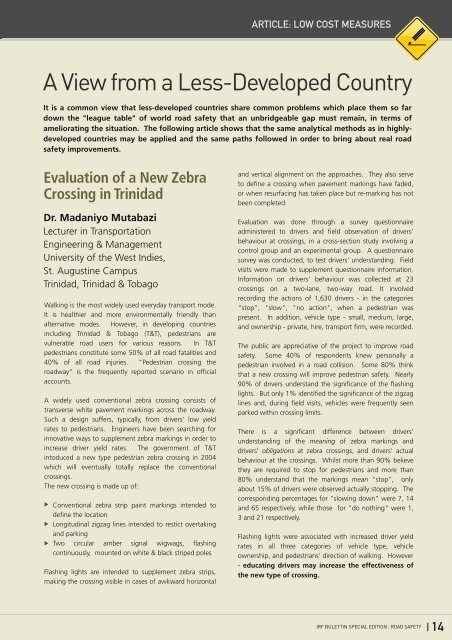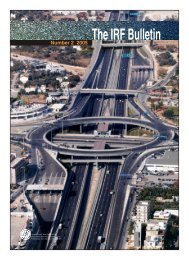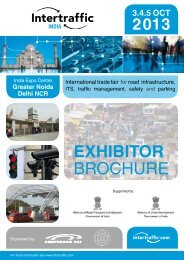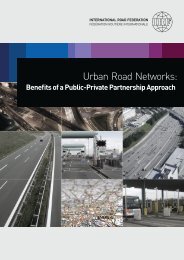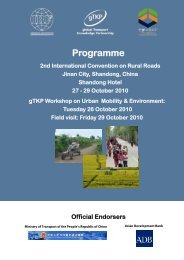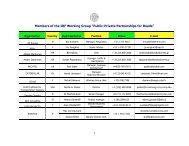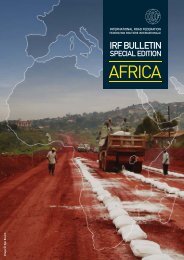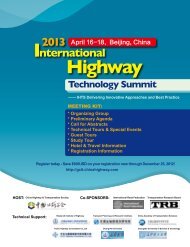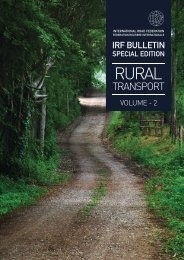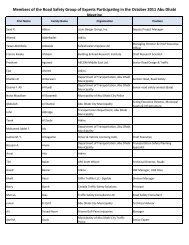IRF's first bulletin fully devoted to the issue of road safety and
IRF's first bulletin fully devoted to the issue of road safety and
IRF's first bulletin fully devoted to the issue of road safety and
Create successful ePaper yourself
Turn your PDF publications into a flip-book with our unique Google optimized e-Paper software.
page14.pdf 10/12/2007 1:34:24 PM<br />
ARTICLE: LOW COST MEASURES<br />
A View from a Less-Developed Country<br />
It is a common view that less-developed countries share common problems which place <strong>the</strong>m so far<br />
down <strong>the</strong> "league table" <strong>of</strong> world <strong>road</strong> <strong>safety</strong> that an unbridgeable gap must remain, in terms <strong>of</strong><br />
ameliorating <strong>the</strong> situation. The following article shows that <strong>the</strong> same analytical methods as in highlydeveloped<br />
countries may be applied <strong>and</strong> <strong>the</strong> same paths followed in order <strong>to</strong> bring about real <strong>road</strong><br />
<strong>safety</strong> improvements.<br />
C<br />
M<br />
Y<br />
CM<br />
MY<br />
CY<br />
CMY<br />
K<br />
Evaluation <strong>of</strong> a New Zebra<br />
Crossing in Trinidad<br />
Dr. Madaniyo Mutabazi<br />
Lecturer in Transportation<br />
Engineering & Management<br />
University <strong>of</strong> <strong>the</strong> West Indies,<br />
St. Augustine Campus<br />
Trinidad, Trinidad & Tobago<br />
Walking is <strong>the</strong> most widely used everyday transport mode.<br />
It is healthier <strong>and</strong> more environmentally friendly than<br />
alternative modes. However, in developing countries<br />
including Trinidad & Tobago (T&T), pedestrians are<br />
vulnerable <strong>road</strong> users for various reasons. In T&T<br />
pedestrians constitute some 50% <strong>of</strong> all <strong>road</strong> fatalities <strong>and</strong><br />
40% <strong>of</strong> all <strong>road</strong> injuries. "Pedestrian crossing <strong>the</strong><br />
<strong>road</strong>way" is <strong>the</strong> frequently reported scenario in <strong>of</strong>ficial<br />
accounts.<br />
A widely used conventional zebra crossing consists <strong>of</strong><br />
transverse white pavement markings across <strong>the</strong> <strong>road</strong>way.<br />
Such a design suffers, typically, from drivers' low yield<br />
rates <strong>to</strong> pedestrians. Engineers have been searching for<br />
innovative ways <strong>to</strong> supplement zebra markings in order <strong>to</strong><br />
increase driver yield rates. The government <strong>of</strong> T&T<br />
in<strong>to</strong>duced a new type pedestrian zebra crossing in 2004<br />
which will eventually <strong>to</strong>tally replace <strong>the</strong> conventional<br />
crossings.<br />
The new crossing is made up <strong>of</strong>:<br />
Conventional zebra strip paint markings intended <strong>to</strong><br />
define <strong>the</strong> location<br />
Longitudinal zigzag lines intended <strong>to</strong> restict overtaking<br />
<strong>and</strong> parking<br />
Two circular amber signal wigwags, flashing<br />
continuously, mounted on white & black striped poles<br />
Flashing lights are intended <strong>to</strong> supplement zebra strips,<br />
making <strong>the</strong> crossing visible in cases <strong>of</strong> awkward horizontal<br />
<strong>and</strong> vertical alignment on <strong>the</strong> approaches. They also serve<br />
<strong>to</strong> define a crossing when pavement markings have faded,<br />
or when resurfacing has taken place but re-marking has not<br />
been completed.<br />
Evaluation was done through a survey questionnaire<br />
administered <strong>to</strong> drivers <strong>and</strong> field observation <strong>of</strong> drivers'<br />
behaviour at crossings, in a cross-section study involving a<br />
control group <strong>and</strong> an experimental group. A questionnaire<br />
survey was conducted, <strong>to</strong> test drivers' underst<strong>and</strong>ing. Field<br />
visits were made <strong>to</strong> supplement questionnaire information.<br />
Information on drivers' behaviour was collected at 23<br />
crossings on a two-lane, two-way <strong>road</strong>. It involved<br />
recording <strong>the</strong> actions <strong>of</strong> 1,630 drivers - in <strong>the</strong> categories<br />
"s<strong>to</strong>p", "slow", "no action", when a pedestrian was<br />
present. In addition, vehicle type - small, medium, large,<br />
<strong>and</strong> ownership - private, hire, transport firm, were recorded.<br />
The public are appreciative <strong>of</strong> <strong>the</strong> project <strong>to</strong> improve <strong>road</strong><br />
<strong>safety</strong>. Some 40% <strong>of</strong> respondents knew personally a<br />
pedestrian involved in a <strong>road</strong> collision. Some 80% think<br />
that a new crossing will improve pedestrian <strong>safety</strong>. Nearly<br />
90% <strong>of</strong> drivers underst<strong>and</strong> <strong>the</strong> significance <strong>of</strong> <strong>the</strong> flashing<br />
lights. But only 1% identified <strong>the</strong> significance <strong>of</strong> <strong>the</strong> zigzag<br />
lines <strong>and</strong>, during field visits, vehicles were frequently seen<br />
parked within crossing limits.<br />
There is a significant difference between drivers'<br />
underst<strong>and</strong>ing <strong>of</strong> <strong>the</strong> meaning <strong>of</strong> zebra markings <strong>and</strong><br />
drivers' obligations at zebra crossings, <strong>and</strong> drivers' actual<br />
behaviour at <strong>the</strong> crossings. Whilst more than 90% believe<br />
<strong>the</strong>y are required <strong>to</strong> s<strong>to</strong>p for pedestrians <strong>and</strong> more than<br />
80% underst<strong>and</strong> that <strong>the</strong> markings mean "s<strong>to</strong>p", only<br />
about 15% <strong>of</strong> drivers were observed actually s<strong>to</strong>pping. The<br />
corresponding percentages for "slowing down" were 7, 14<br />
<strong>and</strong> 65 respectively, while those for "do nothing" were 1,<br />
3 <strong>and</strong> 21 respectively.<br />
Flashing lights were associated with increased driver yield<br />
rates in all three categories <strong>of</strong> vehicle type, vehicle<br />
ownership, <strong>and</strong> pedestrians' direction <strong>of</strong> walking. However<br />
- educating drivers may increase <strong>the</strong> effectiveness <strong>of</strong><br />
<strong>the</strong> new type <strong>of</strong> crossing.<br />
IRF BULETTIN SPECIAL EDITION : ROAD SAFETY<br />
14


